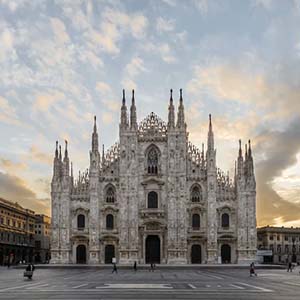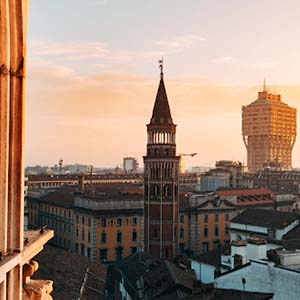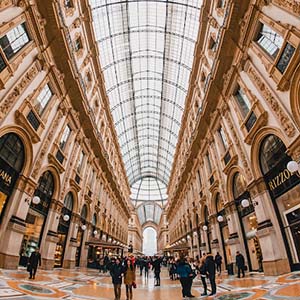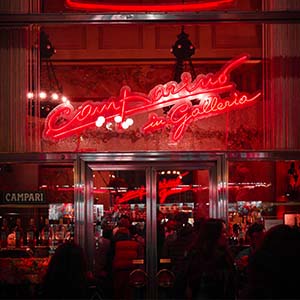Moving to Milan
The city of Milan combines both the modern and traditional, with soaring skyscrapers, historical cathedrals and narrow city streets. Around 1.3 million people living in the city centre enjoy a different pace of life to the rest of Italy, with a bustling and purposeful atmosphere. Likened to the Austrian city of Vienna, Milan’s weather is also different, the surrounding Po Valley can bring cold, foggy, and smoggy conditions.
Milan draws thousands of creatives and designers to its northern location every year. It is home to an ever-expanding fashion and design industry, as well as advertising and communication companies, and it has developed into the financial and commercial centre of Italy.
Orientation
At the centre of the city sits the third largest cathedral in the world, Il Duomo, with the old city surrounding this magnificent and flamboyant Gothic architectural feat. The buildings surrounding the historic city are surprisingly modern due to heavy bombing during WW11. The damage sustained means that there is a charming combination of 18th and early 19th century buildings with post-war architecture.
Hidden beauty is characteristic of this city as you discover charming courtyards behind walls and treasures of art inside ancient churches. Compared to other Italian cities of Florence and Rome, Milan is not as beautiful on the surface, however, it is known for its charming surprises.
Over recent decades, expansion on the outskirts of the city has developed in different forms. Apartment complexes in Milan’s suburbs were initially resisted by many Italians, but more recently there has been more movement into these new spaces.

Things to do in Milan
Have you recently moved to Milan, Italy and are after things to do on the weekend? Take a stroll along the city centre and take in the breathtaking architecture, visit Leonardo da Vinci museum, go luxury shopping in Grand Galleria or grab a bite to eat from a local Italian Restaurant.
Getting around in Milan
Like in many large cities in Italy, Milan’s efficient public transport system is a much quicker and easier way of travelling around than owning a private vehicle. Narrow streets and pollution can make traffic difficult to bear, and the lack of parking in the centre of town can also cause problems. Public transport in Italy is also constantly developing to be more accessible to those who are disabled or have lower mobility.
Buses – Buses in Italy provide a clean, modern, and affordable mode of transport around town. As is normal in large cities, rush hour can mean that buses are very crowded, and you should stay alert for pickpockets. Tickets can be purchased from major bus stops, tobacco shops and newspaper stands, and you must purchase a ticket before boarding a bus. Monthly passes are also available to buy. To validate your tickets, there are stamps on board and you should retain tickets to produce upon inspection and avoid a hefty fine.
Metro – The Metro in Milan, the Metropolitana, is run by Azienda Trasporti Milanesi (ATM). There are 4 colour-coded lines; M1 (red), M2 (green), M3 (yellow) and M5 (lilac). There are 103 stations, and the clean, safe, and inexpensive service runs roughly every 5 minutes from 6 am to 12:30 am, with buses running on weekend nights. Tickets can be purchased at stops, newspaper stands and ticket machines, or you can use one of the various travel cards. Contactless payments are also accepted via card or smartphone and tickets can be purchased on the official ATM app.
Trains – Trenitalia operates the train service across Italy with local, regional and national trains. The Frecce service offers high-speed connections between Milan and Italy’s other major cities. The EuroCity service connects Italy to the surrounding European countries. Several ticketing options are usually available and passengers can purchase tickets at train station kiosks. Tickets must be validated via stamps on platforms and failure to do this can result in a steep fine. More information on tickets, services and schedules can be found via ItaliaRail.
Airports – For International flyers, two Airports serve Milan: Malpensa and Linate. There are bus connections, taxis, and car rental services for travelling between Airport terminals and the city, with an express train service from Malpensa.
Rent or Buy
Most people moving to Milan from the UK opt to rent accommodation rather than to buy. Renting initially is a good idea, even if you plan to buy, as this will give you a chance to check out the area. Luckily, many Italian landlords are keen to rent to foreigners as Italian law makes it virtually impossible to evict an Italian tenant – some people have been known to live rent-free for years. When you are renting, ensure that the property has adequate utilities as some are not hooked up to gas or electricity. There may also be some unexpected expenses, so make sure to ask about all fees.
In Milan, signing a property lease will require the first three months’ rent in advance as well as the security deposit of the same sum. Usually, security deposits are returned at the end of a lease if no damages are discovered. Rent can be paid quarterly or monthly, typically in advance. A lease must be signed for a 4 year period and is then available to be renewed, however companies may lease property for a shorter period, often 18 months.
Buying property in Italy is a time-consuming process full of bureaucracy and can be expensive, even for Italians. We recommend enlisting professional help if you decide to buy accommodation to ensure the property is physically and economically sound. You will need to hire a notary public (nataio), as well as a lawyer (avvacato), an accountant (commercialista) and a surveyor (geometra).

How expensive is the property in Milan?
Rents in Milan are relatively high, though if you are moving to Milan from the UK, they might be lower than you expect. The highest property costs are in Brera, Corso Magenta, Via Giardini, Monte Napoleone and Centro. The Firea and Corso Vercelli are slightly less expensive residential areas, as well as the S. Siro and Via Legioni Romane districts, which are both in close vicinity to the international school of Milan. Arese, Monza and Milano offer some modest priced rental villas and apartments but can be more expensive. Milano 2, San Felice, and other neighbourhoods just outside the city offer larger apartments with more outside space.
With Gerson, our Home Search experts aim to find a property where you and your family feel comfortable when moving to Milan. Find out more about what our Relocation Services include.
Where should I live in Milan?
Tens of thousands of expatriates of all nationalities are living in Milan, scattered throughout urban and rural regions. Housing in Milan is almost exclusively apartments and when houses do rarely come on the market, they are not near schools.
Single adults and families without young children tend to live in the city to make the most of social activities there. Areas outside of the city with more green spaces are more desirable for families with younger children.
Living in the city centre:
Living in Milan’s centre is especially popular among couples and international business people working in Milan with no young children. The fashionable shops and restaurants offer a safe environment to enjoy the atmosphere and there are plenty of services and activities. Pollution from traffic can cause health problems, so trips to the countryside are popular. There are three major English-language schools nearby and you can find religious services that are conducted in foreign languages.
Suburban areas of Milan:
As Milan has developed over the last few decades, new residential communities have evolved, and older nearby towns have become viable neighbourhoods for commuting to the city. The efficient Metro and train systems have made commuting possible from Milan’s suburbs. Some desirable residential areas include Monza, San Felice, Arese, Varese, Milan 2, and Milan 3.
Monza – This lovely suburban town is found slightly north-east of Milan and is known for its beautiful park. The International School and International Community Club make this area very popular with foreigners – many American and British families choose Monza as it is close to the British School and many English preschools. There are many fine sports and fitness facilities, such as the Monza sporting club, and medical facilities in the area are excellent. Extensive opportunities for shopping are also offered here, including 5 shopping malls, elegant shops as well as supermarkets.
Property here is expensive, though not as expensive as Milan, and a range of furnished and unfurnished apartments and houses are available. Milan’s centre is around 30 minutes by car from Monza and just 15 minutes on the train from the nearby metro station.
Milano 2 and San Felice – These residential areas are located to the east of Milan and offer nicely landscaped apartment complexes with trees and lawns, as well as bicycle and pedestrian paths. Constructed in the 1970s, there are nearby supermarkets, shops, and banks. Both suburban areas are near to the British School and there is a school bus running through Milano 2. Both have road or bus connections to a nearby Metro station leading to the city centre.
Arese – This community is a safe and green residential area around 13km northeast of Milan. Convenient to international schools, there are large modern apartment complexes and some free-standing villas. Despite no metro connections, a bus service is available for commuters to travel to downtown Milan.
Varese – This charming town offers single-family homes in townhouse fashion to the northwest of Milan. Each apartment “block” has built-in security and its own amenities, including parking, playgrounds, pools, and tennis courts. The surrounding lakes and hills make for a stunning backdrop and a peaceful atmosphere in this small city. Prices for apartments, more common in the city centre, and houses, more commonly outside the centre, rival those of Monza and are still cheaper than Milan’s centre. The wait for accommodation here can be substantial. There are nearby train connections, but many people choose to own cars in Varese. Due to the European School of Varese, many expats choose to settle here.
Milano 3 – South of Milan, this suburban area is a more modern development. Due to its closeness to the American School, many American families choose to live here. There is also a bus to the Japanese School that runs from Milano 3.
Shopping in Milan
For groceries, Italy’s warm climate allows great quality fresh fruit and vegetables to be grown all year. In Milan, there are daily street markets in different areas of the city selling food and other goods as well as large in- and outdoor markets selling fresh produce. There is an online map of the markets open on different days to help you if you’re moving to Milan. International stores selling imported goods, some with delivery services, are also available across Italy.
Near to Il Duomo in the centre of Milan, the glass-roofed Galleria Vittorio Emmanuele II is home to Milan’s best stores. This elegant space has dozens of high-fashion clothes stores and restaurants and is one of the oldest shopping areas in the world. Known to be the longest shopping street in the world, Corso Buenos Aires, is not far from this historic centre and is home to less expensive stores with great bargains.

Expatriate Community in Milan
There are tens of thousands of expatriates living in Milan. While Italians are very welcoming and warm people, there are also plenty of opportunities to meet other members of the expat community while living in Milan. The Benvenuto Club of Milan joins English-speaking expats together, as well as Italian women, for socialising opportunities. If you are Working in Milan, there will also be plenty of opportunities to socialise with your Italian colleagues.
Our Relocation Services can even assist you to settle into your new surroundings. Find out how we can help today.
Going out in Milan
When working in Milan, you may get accustomed to business lunches or breakfasts. For business or social meals out, there are numerous fine dining establishments in Milan’s centre. The Ticinese and Navigli areas have many restaurants and cafes too, and there are also great restaurants further from the city centre – ask a local friend or colleague for recommendations. Milan’s restaurants can charge high prices. The local cuisine, Lombard, normally includes polenta or risotto and the city is famous for its “Milanese Risotto”, which is rice coloured yellow by saffron seasoning. Fish, despite Milan being home to the largest fish market in the country, is absent from typical Milanese cuisine. There are plenty of other cuisines around the city if you are looking for a change.
Nightlife in Milan is some of the best in the country. Working in Milan might introduce you to some of the best clubs it has to offer. After dark, choose from dance clubs, piano bars and live music venues to spend your evening. Weeknights are the busiest in clubs, especially on Thursday nights. Entry fees to clubs are common, but the cover charge sometimes includes your first drink. Nightspots are concentrated around Brer and Navigli, as well as the Ticinese quarter south of the city.

Entertainment in Milan
Milan is home to some very fine classical music venues and concert halls. The stunning Conservatorio Giuseppe Verdi in Milan offers a wide range of musical genres, not just classical. The Chiesa di San Maurizio, a church built in the 16th century, is also used for classical music concerts. The first 10 days of June are taken up with the Festa del Naviglio, which is filled with parades, music and various performances.
While the opera season begins in early December, the Teatro alla Scala hosts year-round concerts, ballet and theatre. There are also English-language cinemas and local theatres show in other languages too. The Milanomese is a great monthly publication detailing what is happening in Milan, available from the tourist office and online. Hello Milan is also a great source of information
Interested in information on another country? Take a look at our other International Relocation guides.
Great customer Experiences start here
Very pleasent and helpful. Nothing too much trouble.
Mr M H moved from London, UK to Toronto, Canada
Very helpful and patient even when things got packed that we had to get out again!
Mr M E moved from Enfield, UK to Dorset, UK
Thanks to Graham, Nick and the entire crew!
Mr C D M moved from UK to Singapore
Friendly and helpful crew.
Ms T W moved from USA to Cambridgeshire, UK
